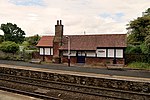St John's Church, Silverdale
19th-century Church of England church buildingsChurch of England church buildings in LancashireChurches completed in 1886Churches in the City of LancasterDiocese of Blackburn ... and 3 more
Gothic Revival architecture in LancashireGrade II* listed churches in LancashireSilverdale, Lancashire

St John's Church is in Emesgate Lane, Silverdale, Lancashire, England. It is an active Anglican parish church in the deanery of Tunstall, the archdeaconry of Lancaster, and the diocese of Blackburn. The church is recorded in the National Heritage List for England as a designated Grade II* listed building. It is notable for the high quality of the stone carving in the interior.
Excerpt from the Wikipedia article St John's Church, Silverdale (License: CC BY-SA 3.0, Authors, Images).St John's Church, Silverdale
Emesgate Lane, Lancaster Silverdale
Geographical coordinates (GPS) Address External links Nearby Places Show on map
Geographical coordinates (GPS)
| Latitude | Longitude |
|---|---|
| N 54.1716 ° | E -2.8238 ° |
Address
St John
Emesgate Lane
LA5 0RA Lancaster, Silverdale
England, United Kingdom
Open on Google Maps










